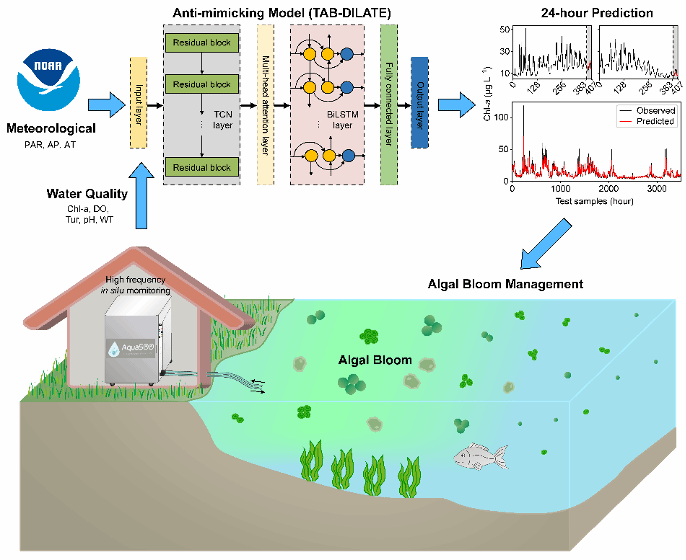Abstract
Accurately predicting algal blooms remains a critical challenge due to their dynamic and non-stationary nature, compounded by high-frequency fluctuations and noise in monitoring data. Additionally, a common issue in time-series forecasting is data replication, where models tend to replicate historical patterns rather than capturing true future variations, leading to inaccurate forecasts during abrupt changes. To address these challenges, we developed a hybrid deep learning model (TAB) that integrates a Temporal Convolutional Network (TCN), an attention mechanism, and Bidirectional Long Short-Term Memory (BiLSTM) network. Furthermore, we employed a novel distortion loss function—DIstortion Loss including shApe and TimE (DILATE)—which incorporates both shape and temporal losses to enhance the model's predictive robustness. Using in situ algal bloom data from Jiangdong Reservoir, Jiulong River, China, the TAB model accurately forecasted hourly chlorophyll-a dynamics for the subsequent 24 h, achieving an R2 of 0.74, a mean absolute percentage error of 21.22%, a root mean square error of 4.12 μg L−1, and a Kling-Gupta efficiency of 0.78. The DILATE loss function effectively mitigated data replication and improved low-peak chlorophyll-a prediction accuracy by 10.57%, compared to the traditional mean squared error (MSE) loss, particularly in the concentration range of 0–20 μg L−1, which represents the most frequently observed levels in the dataset. SHapley Additive exPlanations (SHAP) analysis identified key environmental drivers, improving model interpretability and computational efficiency. This study demonstrates the potential of advanced deep learning models in algal bloom prediction and provides insights for further optimization in forecasting performance and broader applications.

Zhang Yaqin, Yichong Wang, Jixin Chen, Lizhen Lin, Wupeng Xiao* & Bangqin Huang, Enhancing short-term algal bloom forecasting through an anti-mimicking hybrid deep learning method. Journal of Environmental Management, 379, 124832, 2025.
https://doi.org/10.1016/j.jenvman.2025.124832